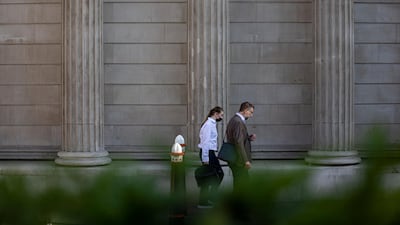Britain’s unemployment rate dipped to 4.7 per cent in April as the number of employees on company payrolls surged by a record 197,000 staff as coronavirus restrictions were eased gradually.
The jobless rate in the three months to the end of April improved on the 4.8 per cent in the previous three-month period, representing the fourth monthly fall in a row, the Office for National Statistics said.
The positive data comes a day after the government delayed the final stage of the pandemic road map by four weeks amid rising Covid-19 cases.
The number of people on payrolls is now 28.5 million – still 553,000 below pre-Covid levels – while vacancies soared as employers struggled to fill positions created by a shortage of workers in sectors such as hospitality.
"The latest forecasts for unemployment are around half of what was previously feared and the number of employees on payroll is at its highest level since April last year," Chancellor of the Exchequer Rishi Sunak said.
“We understand the value of work and the distress caused by unemployment – that is why we are continuing to support people and jobs.”
The Bank of England said last month that unemployment would only rise modestly when the furlough scheme stops at the end of September.
The number of vacancies in the quarter to May was 758,000, only 27,000 below the March 2020 level with the strongest increase in the accommodation and food sectors.
London-based audit and consulting firm PwC said on Tuesday it was planning to hire 100,000 people across the globe over the next five years, mostly for its overseas offices with a $3bn plan to double its Asia-Pacific business.
Meanwhile, the UK redundancy rate returned to levels seen before the start of the pandemic, the ONS said, but younger employees were being frozen out with 126,000 fewer under-25s on payrolls in the year to May and London residents particularly affected.
ONS head of economic statistics Sam Beckett said early estimates suggested that by May the job vacancy total had surpassed its pre-pandemic level, with strong growth in hospitality.
But with 3.4 million people still on furlough, analysts said recovery in the employment still has some way to go.
“Jobs are heading in the right direction, but after the road map to reopening was delayed for four weeks, we can’t rule out a dangerous detour as we head into the summer,” said Sarah Coles, personal finance analyst at Hargreaves Lansdown.
“Pushing the full reopening of the economy back four weeks could be a horrible blow for the jobs market. The continued recovery of employment depends on people being able to return to work and on businesses staying open and viable.”
Even if the full reopening goes ahead on July 19, Ms Coles said the BoE was expecting 500,000 people to still be on furlough when it was withdrawn in September, so unemployment would peak at 5.5 per cent in the autumn.
“If we reach the end of the summer with more restrictions in place and more jobs relying on government help, the rise in unemployment could be more significant,” she said.
Laith Khalaf, financial analyst at AJ Bell, was also cautious about the dials in the labour market now pointing in the right direction.
“We won’t get a clear picture of the health of the post-pandemic economy until the back end of this year and that means the Bank of England isn’t going to rush to any interest rate hikes in the next few months, even if the UK looks to be firing on all cylinders," he said.


